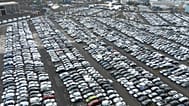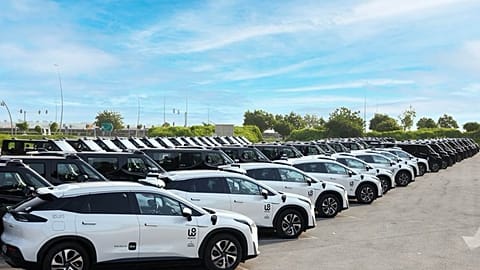At FIRA USA 2025 in California, the future of farming was on full display, with driverless tractors, drones and AI-powered machines navigating fields and tending crops.
In a field outside Woodland, California, a bright orange tractor hums to life. But there’s no one in the driver’s seat.
Instead, it chugs its way through neat rows of crops, spraying a mist over the soil, guided entirely by sensors and software.
This is the next generation of tractors - and it was on full display at FIRA USA 2025, an agricultural robotics expo showcasing the latest in autonomous tractors, drones and AI-powered farm tools.
"Today we've been demonstrating multiple Kubota tractors that have Agtonomy technology integrated by Kubota that can operate fully autonomously," said Tim Bucher, CEO and co-founder of Agtonomy, a Silicon Valley start-up powering some of these machines.
The technology, developed in partnership with Japanese manufacturer Kubota, allows one person to oversee an entire fleet of self-driving tractors. "You can now have one person managing multiple vehicles, essentially cloning themselves, getting work done in parallel," Bucher explained
Innovation born out of necessity
For many growers, automation is no longer a luxury - it’s survival. Rising costs, trade tensions and a chronic shortage of labour have left the agricultural sector under immense pressure.
"The challenges facing growers have never been as big as it is today. And it's about labour expenses, it's about other expenses, whether it's the tariffs or trade wars and whatnot," said Bucher. "So growers are looking for anything to make their operations more efficient. And the only way out is to innovate our way out".
In Japan, where Kubota is headquartered, the crisis is in a particularly critical situation.
"Especially in Japan, the average age of the farmers now is 69 years old, and it's a very ageing society. And we are also losing a significant amount of labourers from our farming operations," said Koji Hasegawa, General Manager of Kubota’s Innovation Center.
The labour dilemma
For Walt Duflock, vice president of innovation at the Western Growers Association, the problem comes down to economics.
"It is the number one problem, especially crop growers face, is the decreasing availability of domestic labour and the increasing cost of domestic labour and, more importantly, international labour," he said.
"Either we get that cost of labour down by moving the agricultural operation to where the labour is cheaper, or we automate it with robots".
Beyond cost-cutting, Duflock hopes automation could also make agriculture appealing again to younger generations.
"Like a moth to a flame for the robots, so we think the robots are the way to get kids excited, and we think that can bring kids back to the farm that maybe wouldn't have come back to the farm," he said.
Currently, the average age of an EU farmer is 57 and only 12 per cent are under the age of 40, according to the European Commission.


















